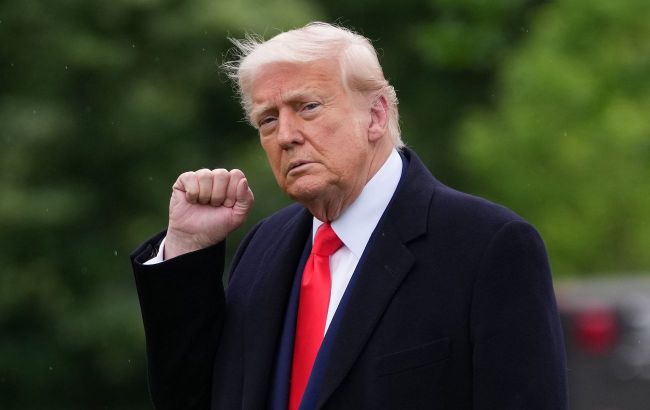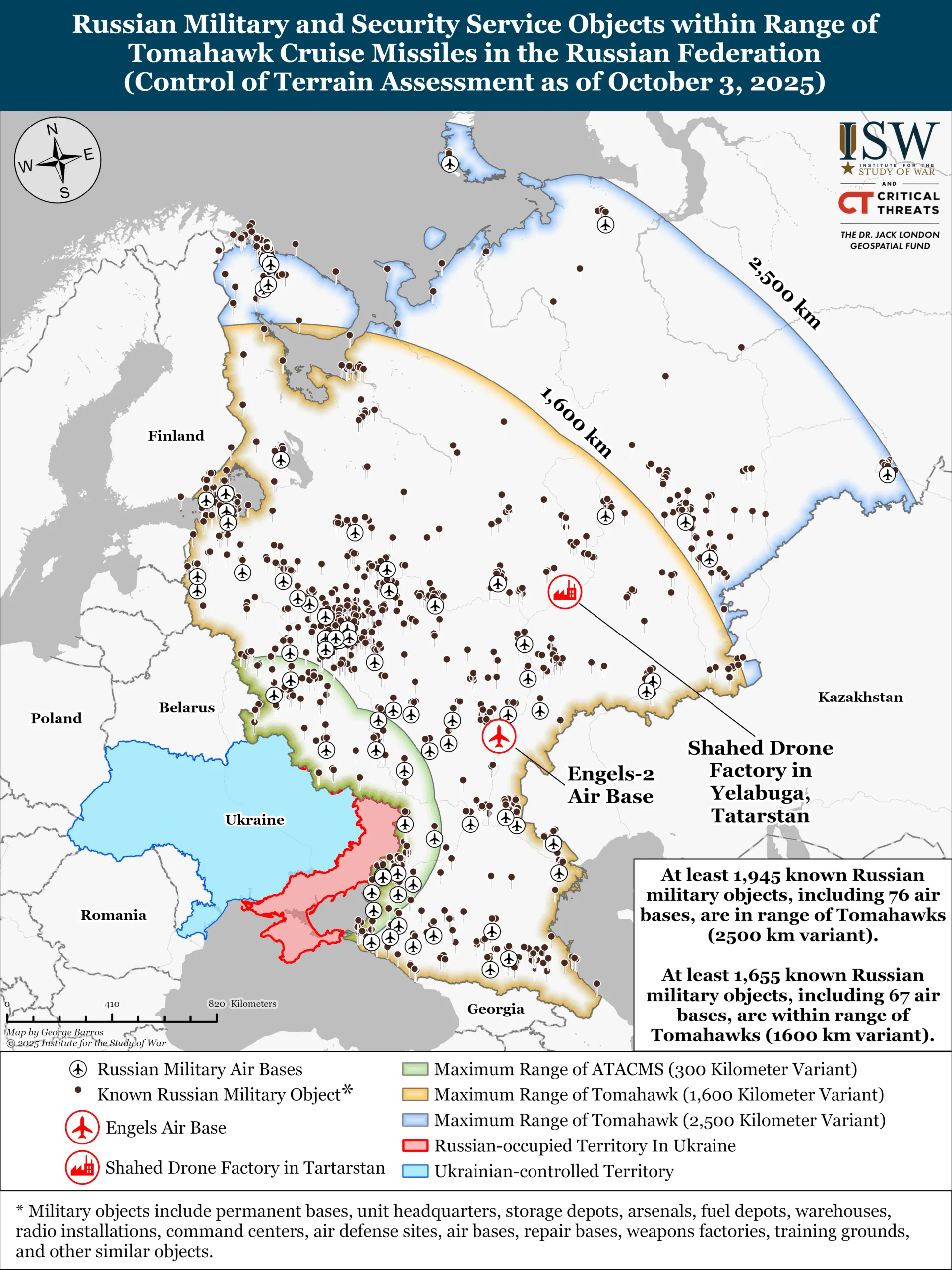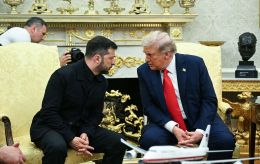Trump's Tomahawks: Could US missiles change Ukraine's fight?
 Photo: Donald Trump, 47th US President (Getty Images)
Photo: Donald Trump, 47th US President (Getty Images)
US President Donald Trump stunned everyone with a statement about an almost finalized decision to supply Tomahawk missiles to Ukraine. What's behind this move, whether the Ukrainian Armed Forces will actually receive the American strategic missiles, and how this could impact the situation on the front line — read in the piece by RBC-Ukraine.
Key questions:
- Will Ukraine get Tomahawk missiles?
- Why has Trump's rhetoric suddenly changed?
- What's the connection between the Tomahawk deal and Ukraine’s security guarantees?
The BGM-109 Tomahawk cruise missile is a legendary symbol of American power and precision — the weapon that opened most US military campaigns, from Desert Storm to the strikes on Syria. Now, this "winged axe," capable of hitting targets up to 1,800 kilometers away, could potentially be used in Ukraine's war against Russia.
"I sort of made a decision pretty much. I think I want to find out what they're doing with them, where they're sending them, I guess. I have to ask that question. I'm not looking to see escalation," Trump told reporters on Monday when asked whether he would transfer the missiles to Ukraine.
However, his vague statement was followed by no specifics. On the contrary, the expert community, along with US media outlets, was quick to temper the initial wave of excitement.
Limited stockpiles and fear of losing control
The main technical problem with the Tomahawk is that these missiles were originally designed as weapons for the US Navy. They can only be launched from ships and submarines, meaning Ukraine simply lacks the infrastructure to operate them. The only possible option is the land-based Typhon launch system, which can fire Tomahawks from the ground. However, its numbers are extremely limited — just two batteries with four launchers each.
"The US is already facing serious production problems with Patriot missiles — they only produce a few each month. The same applies to Tomahawks. They're being made almost individually — about four to eight units per month. So there's a shortage not only of launchers, but of the missiles themselves," said Anton Zemlyanyi, senior analyst at the Ukrainian Security and Cooperation Center, in a comment to RBC-Ukraine.
Still, if there's political will, a solution can always be found, the analyst added. The West has repeatedly overcome technical and logistical barriers that once seemed impossible — from HIMARS and F-16 fighter jets to Storm Shadow missiles successfully integrated even with Soviet-era aircraft.
"So, practically, the transfer of Tomahawks is entirely possible. The key is finding the political will to make it happen," he said.
A US official familiar with the Tomahawk supply issue told Reuters there's no missile shortage, but questioned the wisdom of transferring them. The reason lies in strategic planning — existing stockpiles are reserved for US Navy needs.

Launch of a Tomahawk missile from a US Navy ship (photo: Getty Images)
Meanwhile, according to the official, Washington is more likely to consider systems with a shorter range or allow European allies to purchase and transfer other long-range systems to Ukraine.
Another concern among US officials is the fear of losing control over missiles capable of reaching Moscow from virtually anywhere in Ukraine. As Axios reported, Washington still doesn’t fully understand whether it will retain any control over the use of Tomahawks acquired by NATO countries for Ukraine.
According to Volodymyr Fesenko, head of the Center for Applied Political Studies Penta, the US could impose restrictions on Tomahawk use — similar to the limitations placed on ATACMS, another long-range missile system that the previous US administration long prohibited from being used on Russian territory.
"I think there may be restrictions. Not necessarily on range, but on specific targets. For example, it might be prohibited to strike Moscow, nuclear power plants, or sites storing nuclear weapons, if such locations are known," Fesenko told RBC-Ukraine.
Still, even if Ukraine receives Tomahawks, the overall impact of these missiles on the course of the war remains highly uncertain.
Game-changer or pressure tool?
The hype around Tomahawks is far from the first of its kind. Every time talk begins about the potential transfer of new Western weapons to Ukraine — whether it's Abrams tanks, F-16 fighter jets, or long-range missiles — discussions immediately start about whether it will be a game-changer.
Analysts at the American Institute for the Study of War (ISW) suggested in one of their assessments that Tomahawks have the potential to significantly weaken the combat effectiveness of the Russian army. The key advantage of these cruise missiles is their powerful warhead, capable of destroying targets deep behind enemy lines.
According to ISW's estimates, at least 1,945 Russian military sites are within Tomahawk's range. Strikes with these missiles could seriously damage or destroy critical targets inside Russia — for example, the Shahed drone factory in Yelabuga or the Engels-2 airbase, where Tu-95 bombers take off.

Russian targets within Tomahawk strike range (photo: understandingwar.org)
However, as practice shows, limited arms deliveries — even if the weapons prove highly effective in specific areas of the front — rarely change the overall balance of the war in Ukraine’s favor.
"It's unlikely that Tomahawks will be real game-changers. More likely, their transfer would be a political move rather than a purely military one," says analyst Zemlyanyi.
Still, the fact that the Tomahawk issue is now being discussed publicly means the topic is no longer taboo, notes Fesenko. According to him, that alone marks a major step forward in relations with the US administration.
"In our dialogue with the Americans about weapons, there are always three stages. First, they tell us no — sometimes they say never. The second stage is when the topic becomes open for discussion. The third is when we actually receive the weapons — usually in limited numbers or with certain restrictions. I think we're now at the second stage,” the political analyst said.
Experts believe the Tomahawk announcement is a new form of pressure on the Kremlin. Trump is deliberately raising the stakes in his dialogue with Moscow after the setback in Alaska, finding himself in an awkward position and needing to project strength. That's why his rhetoric has shifted, Zemlyanyi explained.
 Volodymyr Zelenskyy and Donald Trump, September 2024 (photo: Getty Images)
Volodymyr Zelenskyy and Donald Trump, September 2024 (photo: Getty Images)
Despite Moscow's loud threats to destroy relations with Washington and its warnings of escalation in the war against Ukraine, Trump's administration isn't backing down, Fesenko noted. It continues to ramp up pressure by fueling talk about a possible Tomahawk transfer to Ukraine.
"There's still no decision to supply Tomahawks at this point. Who knows — Trump might eventually go for it. Sometimes he's completely unpredictable and can make sudden, surprising moves. But for now, it looks more like a tool of pressure on Russia. That's the most likely scenario," the political analyst added.
And Ukraine itself, it seems, is viewing these missiles from a very different, long-term perspective.
Weapon of deterrence
Talk of Ukraine's interest in acquiring Tomahawks first surfaced back in the fall of 2024, when President Volodymyr Zelenskyy brought his "victory plan" to the United States. According to US media, the classified section of that plan mentioned the transfer of missiles as part of a non-nuclear deterrence package.
At the time, Joe Biden's administration rejected the request. Anonymous officials described the idea as an "absolutely unrealistic proposal." The issue was also raised in discussions with Donald Trump, who was then still a presidential candidate.
"During the latest meeting, I didn't hear a 'no.' I heard that they'll start working on it at the technical level and consider the possibility. That's an important signal right now — strengthening Ukraine by all available means. One of those means, which I personally consider crucial, is Tomahawks. Such things can make Ukraine stronger and force the Russians to sober up — to cool off a bit and come to the negotiating table," Zelenskyy told journalists recently.
According to experts, American Tomahawks in Ukraine could indeed become part of future security guarantees after the war ends — serving as a deterrent against another Russian attack.
"That's exactly how this issue was framed last year, looking ahead, and I think it's still being discussed. We're negotiating with both Europeans and Americans. You could call it a kind of security guarantee, though of course, there's no such thing as an absolute guarantee. Still, it's a pretty serious weapon of deterrence," said political analyst Volodymyr Fesenko.
***
Overall, experts note that the potential Tomahawk transfer is a political decision — one that could be implemented in Ukraine at some point in the future. While it would certainly symbolize long-term American support, it wouldn't have a direct strategic impact on the current battlefield situation.
For now, it's more advantageous for Ukraine to focus on developing its own long-range strike capabilities. Systems such as Flamingo and Neptune, along with other domestically produced weapons, are comparable to Tomahawks in range, are not subject to political decisions by foreign partners, and have already proven their effectiveness in the war against Russia.
Sources: Reuters, Axios, The New York Times, Institute for the Study of War, statements by US President Donald Trump and Ukrainian President Volodymyr Zelenskyy, comments from Volodymyr Fesenko (Center for Applied Political Studies Penta), and Anton Zemlyanyi (Ukrainian Security and Cooperation Center).

